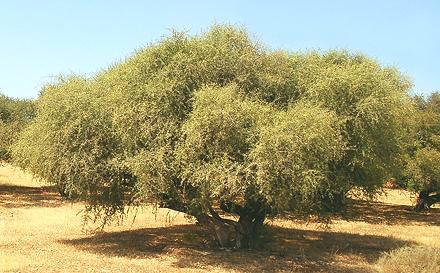 [Argania spinosa]
[Argania spinosa]
The argan tree, once fairly widespread in North Africa, is now pretty much restricted to parts of Morocco. The tree is a remanent population surviving from the Tertiary geologic era and is now considered endangered due to overgrazing by goats, charcoal manufacturing and encroachment of agriculture. UNESCO has designated the forests as a Biosphere Reserve, but the best bet on its survival is commercial value. Photo © Luc Viator distributed under license Creative Commons Attribution-ShareAlike 3.0 Unported
Due to conservation efforts, the oil is now being exported to Europe and North America, at prices ranging up to 2011 US $80 per half liter. In parts of Morocco the oil is used as a substitute for Olive Oil, for dipping and cooking, so it can be important in accurately reproducing Berber cuisine. It is also, due to its unique nutty flavor (and high price), being adopted by high end chefs in Europe and North America for some of their more expensive preparations. It has also long been used as a cosmetic oil due to it's high content of Vitamin E and phenols, useful for rejuvenating skin.
The seed kernels are removed from the fruit shell and lightly roasted, giving the oil a nutty flavor. They are then ground and the oil is extracted by pressure, once by hand, now by mechanical presses. The left over meal is used as animal feed.
A very drought resistant tree, the Argan is fed upon mainly by goats,
which are agile enough to climb onto even high branches. Traditionally,
the oily seeds were recovered by washing them out of goat droppings.
Today this method is still widely used, but for commercial product the
goats are restricted and the fruit mechanically harvested. The oil is
manufactured by a number of Moroccan Women's Cooperatives.
More on Culinary Oils.
oi_arganz 110101 - www.clovegarden.com
©Andrew Grygus - agryg@clovegarden.com - Photos
on this page not otherwise credited © cg1
- Linking to and non-commercial use of this page permitted